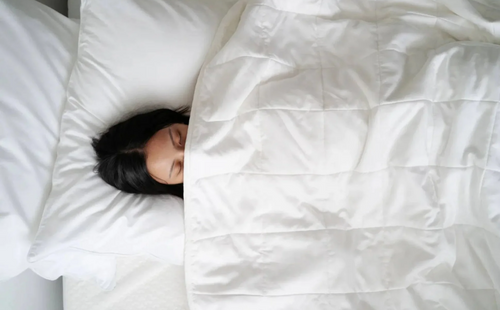Our nighttime environments can be just as unpredictable as those in our waking hours. For those in temperate countries, a common night’s sleep could range from sizzling summers to cold winters. But for Singaporeans, this could simply be whether or not you choose to turn on the aircon or the dehumidifier for the night.

Image By Alex Green From Pexels
But whether it be circumstantial or by choice, what if you had a two-in-one blanket that you can use for both the hot and cold season? This is exactly what an all season duvet provides.
Here, we'll answer: what is an all-season duvet and how do they set themselves apart from the rest? Read on to find out.
What Is An All Seasons Duvet?
Also known as a four-season duvet, an all season blanket is a convenient way to be sure you're at the right temperature in bed all year round.

Image by Andrea Piacquadio from Pexels
This type of bedding comprises a lighter and a heavier blanket, both of which have different thermal settings. It is a versatile bedding item accessible to different types of sleepers regardless of climate - like a hot and cold duvet in one.
How It Works
The concept of this type of bedding is to provide you with two separate blankets with different TOG (Thermal Overall Grade) ratings, which can be used separately or combined together to create a warmer bedding.
TOG is a metric that pertains to warmth, which determines how much heat a blanket can trap inside. On a scale of 1-15, the higher the tog, the warmer the blanket. A lower rating means that the bedding is thinner and more breathable, making it ideal for warmer weather. On the other hand, a higher TOG rating indicates a thicker and warmer blanket, perfect for colder temperatures.
The beauty of these duvet types lies in its ability to switch settings. During the summer months, you can use the lighter 4.5 TOG to keep you cool and comfortable. This blanket is ideal for those who tend to get hot while sleeping, as it allows for better air circulation and ventilation. As the weather begins to get cooler in the autumn and spring, you can switch to the 9 TOG for a little more warmth.

Image By Miriam Alonso From Pexels
When winter comes, you can combine the two together to create a super cosy 13.5 TOG. This is achieved through buttons, ties, or plastic fasteners, which hold the two blankets together securely. By doing so, you get one that provides the perfect balance of warmth and comfort, keeping you snug and comfortable on those cold winter nights.
Setting The All Season Duvet Apart
What makes this special blanket different from others? Aside from the thermal properties, they can also have distinctions in appearance which can help you recognise which is which at a glance. We’ll dive into every aspect in this section.
Ordinary Duvet Vs All-Season Blanket

Featuring Weavve’s TENCEL™ Lyocell Duvet
Their key distinction boils down to flexibility. A regular duvet normally has one setting - either it cools or warms. As mentioned, an all season version has two settings, used alone or together as needed. However, some thermal-regulating blankets are suitable for different types of weather as the material adjusts according to the environmental temperature.
Thinner blankets would also weigh around 400gsm and below, while thicker ones would weigh around 600-800gsm. As the best of both worlds, an all season bedding is at a medium weight of 400-600gsm.
Other Blankets Vs All-Season Duvets

Image By Cats Coming From Pexels
There are also other blanket types being compared to duvets, such as comforters or quilts. However, these three have distinct characteristics. The main difference between a comforter vs duvet vs quilt is the appearance and feel.
A comforter in Singapore is popular for those making their beds in a rush. This one-piece blanket results in a fixed appearance and purpose - keeping you warm.
An all-season blanket with cover is more flexible when it comes to design and function. Covers can be changed to match whatever design strikes your fancy. And as mentioned, it is composed of two separate blankets (light and warm) with different TOG ratings.

Image By Erik Mclean From Pexels
Meanwhile, a quilt and quilt cover in Singapore are crowd favourites as these are better suited for warmer climates. This is in contrast with all-season blankets with temperature-regulating properties which are compatible with both warm and hot seasons.
In terms of designs, quilt covers may be a bit too dated for current tastes as compared to modern covers like an all-season blanket. And as a one-piece material, quilts are challenging to launder regularly as well.
Pros Of All Seasons Duvet
Knowing the advantages and disadvantages of this blanket type is key to assessing if it is a right fit for you. Now, let’s start with its benefits.
Versatile

Image By Pavel Danilyuk From Pexels
All season duvets are ideal for those sensitive to changing climates, or those just plain indecisive on how they like to sleep each night. Maybe you have come from the office looking for a warmer bed or you might need to cool off after a hot day. Having the option to sleep wrapped in a toasty warm blanket or a light and cool one on a whim makes for a great night’s sleep each time.
Good For Sensitive Skin
These types of blankets are often made with high-quality materials such as cotton, silk, wool, or even an all season down duvet. These materials are hypoallergenic and gentle on the skin, making them an excellent choice for those with sensitive skin.

Image By EKATERINA BOLOVTSOVA From Pexels
Convenient
With an all seasons bedding, you get the convenience of having two duvets in one. Instead of having to purchase separate blankets for different seasons, you can switch between the two or combine them together as needed.
Cons Of All Seasons Blanket
It may sound great and all, but there are also downsides you need to consider before you purchase this type of blanket.
Can Be Bulky
Since an all seasons bedding is essentially two blankets in one, it can be quite bulky and take up a significant amount of storage space. This might be a bit cumbersome for those who have limited storage space in their homes.

Image By cottonbro studio From Pexels
If you’re not using both blankets together, you would need extra storage space or a guest room, doubling as an extra bedding for guests.
Costly
All season versions are often more expensive than regular ones. This is because they are made with high-quality materials and offer more versatility. However, the cost can be a deterrent for those on a tight budget.
Although some would argue that they are, in reality, more cost-friendly in the long run. Instead of having to purchase both a summer duvet and a winter duvet, you only need to invest in one suitable for changing climates.
Should I Buy An All Seasons Bedding?
Knowing the advantages and disadvantages of an all season duvet is key to assessing if these types of duvets are fit for you. First off, all season duvets are more cost-friendly in the long run - allowing you to get two duvets at a lower price.

Featuring Weavve’s TENCEL™ Lyocell Duvet
The answer boils down to your needs, preferences, and budget. Consider the climates of the area you’re living in. Note that there are countries that only have wet and dry seasons and even those that are just either hot or cold all year round. If you live in one of those, you might have to think twice before making a purchase.
Think of your comfort as well. Are you someone who easily gets cold or hot and or simply wants to indulge in a restful night throughout the year? Then buying an all seasons blanket may be a smart move!
Lastly, take into account your budget. As discussed, it can be more costly but can also let you save in the long run as there is no need to get separate blankets to adapt to the changing seasons. Alternatively, you can buy a duvet with excellent tempering-regulating properties. It is designed to keep you comfortable through both hot and cold nights.
Looking for a duvet in Singapore suitable for both wet and dry seasons? Check out Weavve Home’s 100% pure TENCEL™ Lyocell Duvet - no blend!





































